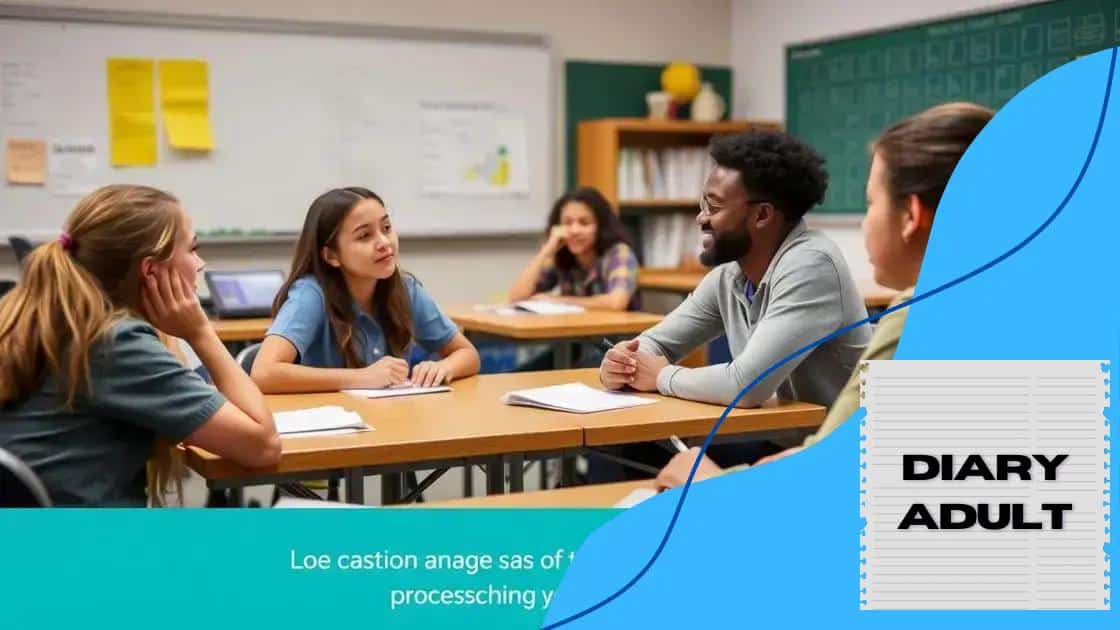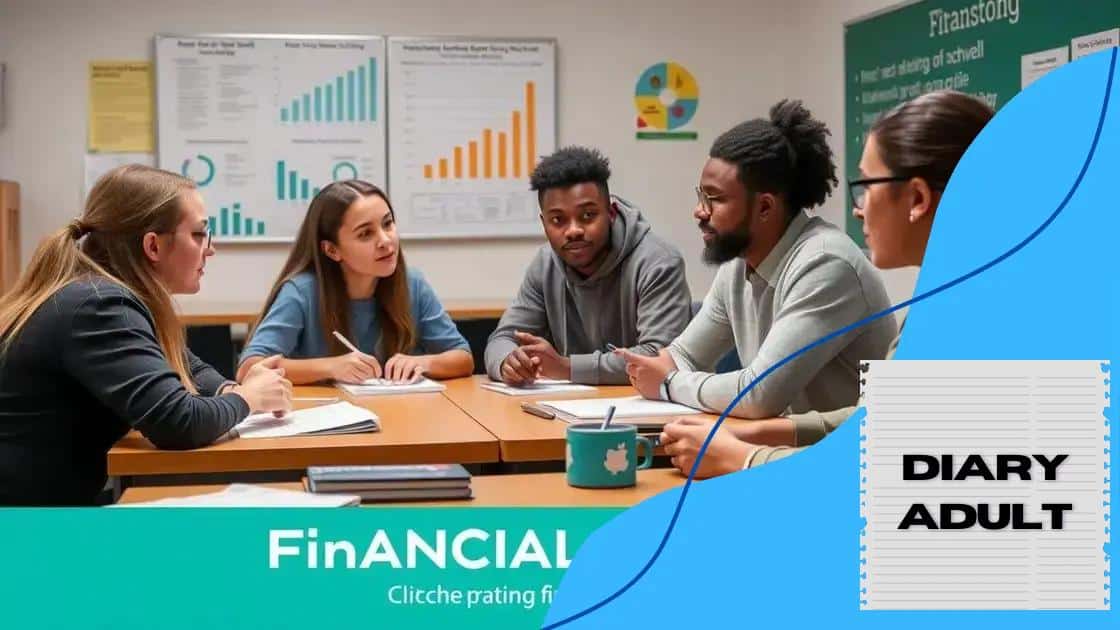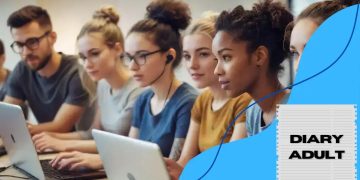Financial literacy education in high school curriculums: a necessity

Financial literacy education in high school curriculums equips students with essential skills for managing personal finances, making informed decisions, and preparing for real-life financial challenges.
Financial literacy education in high school curriculums is crucial for equipping students with essential money management skills. Have you ever wondered how well-prepared young adults are when faced with financial decisions? In this article, we’ll dive into the key elements of financial education and its impact on students.
Understanding financial literacy and its importance
Understanding financial literacy is vital in today’s fast-paced world. It helps individuals make informed decisions about their money, leading to a secure financial future. By learning basic concepts today, students can better manage their finances tomorrow.
What is Financial Literacy?
Financial literacy refers to the ability to understand and effectively use various financial skills. This includes budgeting, saving, investing, and understanding credit. It’s important because it empowers people to take control of their financial life.
Why is it Important?
Understanding financial literacy helps people navigate everyday challenges. When students know how to budget, they can avoid debt. Having the skills to manage money makes life decisions easier.
- Better money management leads to less financial stress.
- Informed decisions about loans and credit.
- Ability to save for goals like college or a car.
Additionally, financial literacy can boost confidence. When people feel secure in handling their finances, they are more likely to invest in their future. This proactive approach to financial management is vital for success.
Real-Life Applications
Implementing financial literacy in high school prepares students for real-world scenarios. This not only covers personal finance but also enhances skills useful in future careers. For instance, understanding credit scores affects job applications and housing opportunities. When young adults grasp these concepts, they make better decisions that lead to a more stable financial life.
Incorporating financial literacy education into school curriculums addresses urgent needs and prepares students for adulthood. This knowledge is essential, as students will face financial challenges shortly after graduation.
Key topics to include in high school finance classes
When designing finance classes for high school students, it’s essential to cover key topics that engage and inform. These subjects equip students with the necessary skills to navigate their financial futures effectively. Incorporating practical lessons ensures students can apply what they learn in real life.
Essential Topics for Finance Classes
Below are vital topics that should be included in finance classes:
- Budgeting: Teaching students how to create and manage a budget is fundamental. It helps them understand income, expenses, and savings.
- Saving and Investing: Students should learn the importance of saving money and the basics of investing. Understanding how to grow wealth is crucial for their future.
- Credit and Debt: Understanding credit scores, loans, and how debt works forms a critical part of financial literacy. This helps students avoid pitfalls later in life.
- Financial Decision Making: Students should develop skills in making informed financial decisions. This includes analyzing options and evaluating risks.
Additionally, students benefit from real-life scenarios where they can practice these skills. Role-playing exercises help them make financial decisions in a safe environment. For example, simulating a job interview can teach them how to negotiate salary and benefits. This also gives them practical experience in managing income.
The Role of Technology
In today’s tech-driven world, incorporating technology into finance education is vital. Students can learn to use budgeting apps and online investment platforms. Understanding these tools enhances their financial skills and prepares them for the modern economy.
By including these key topics in high school finance classes, educators can help students develop a strong foundation in financial literacy. This preparation is essential for ensuring they are confident and equipped to face future financial challenges.
How financial literacy benefits students in real life

How financial literacy benefits students in real life is a crucial topic, as understanding finance can dramatically impact students’ futures. Gaining financial knowledge helps students make informed decisions and promotes positive habits that last a lifetime.
Real-Life Applications of Financial Literacy
Financial literacy equips students with skills they can use immediately. When students learn to budget, they see how managing money can help them save for things they want or need. Additionally, they become aware of the importance of having an emergency fund for unexpected expenses.
- Improved Spending Habits: When students master budgeting, they learn to differentiate between wants and needs.
- Making Smart Investment Choices: Understanding the basics of investing allows students to start building wealth early.
- Managing Debt Responsibly: Students become aware of the consequences of debt, helping them avoid excessive loans and credit issues.
Another significant benefit of financial literacy is enhanced confidence. When students feel capable of managing their finances, they approach financial challenges more positively. This confidence extends beyond individual finances, affecting their career choices and entrepreneurial pursuits.
Long-Term Benefits for Future Success
Financial literacy also prepares students for adult responsibilities. Knowing how to navigate loans, credit cards, and mortgages is essential for future success. These lessons make entering adulthood smoother. In a world where financial decisions are unavoidable, being educated allows young people to thrive.
Moreover, financial literacy contributes to greater overall financial security. When students are educated, they are less likely to fall into debt traps and will more likely be homeowners or investors. Promoting financial education in schools creates a generation of financially savvy adults.
Implementing effective teaching strategies
Implementing effective teaching strategies in financial literacy classes is crucial for engaging students. These strategies help students connect with the content and apply it to their lives. By using interactive methods, teachers can foster a deeper understanding of financial concepts.
Interactive Learning Techniques
One way to make finance lessons engaging is through interactive activities. Group discussions allow students to share experiences and learn from each other. Hands-on projects, such as creating a personal budget, help students visualize financial concepts.
- Case Studies: Analyzing real-life financial situations encourages critical thinking.
- Simulations: Role-playing scenarios, like job interviews or investment decisions, lets students practice making financial choices.
- Games: Utilizing games can make learning fun and memorable, reinforcing key concepts.
Another effective strategy is incorporating technology into lessons. Online tools and resources allow students to access information quickly. For example, financial apps can be used to illustrate budgeting in real-time. Integrating technology not only captures students’ attention but also prepares them for a digital world.
Building a Supportive Environment
Creating a supportive classroom environment is just as important. Encouraging questions helps students feel comfortable exploring complex topics. Teachers should be approachable and provide assistance when needed. This environment promotes open dialogue, strengthening students’ understanding of financial literacy.
Lastly, relevant guest speakers can inspire students. Financial professionals sharing their knowledge and real-world applications of finance can make a lasting impact. Such interactions show students the value of financial literacy in their future careers.
Resources for enhancing financial education in schools
There are numerous resources available for enhancing financial education in schools. Utilizing these tools can significantly improve students’ understanding of financial literacy concepts. Teachers can find various materials that cater to different learning styles and needs.
Online Platforms and Tools
One popular resource is online platforms that offer courses and modules specifically designed for young learners. For example, websites like Khan Academy provide free lessons on personal finance. These platforms often include interactive quizzes, which help reinforce learning.
- MoneySmart: This site offers courses tailored for students, covering everything from basic budgeting to investing.
- Everfi: An interactive platform that provides financial literacy education through engaging activities.
- MyMoney.gov: A U.S. government website that offers excellent resources for teaching financial literacy.
Utilizing these platforms not only makes learning fun but also encourages students to take initiative in their financial education. In addition, many of these resources provide teachers with guides and lesson plans that simplify the teaching process.
Community Programs and Workshops
Local community organizations often host financial literacy workshops for students. These programs can be immensely beneficial because they provide real-world applications and insights into money management. Inviting guest speakers from local banks or financial institutions can also enhance the learning experience.
Another great resource is partnerships with local businesses that can offer internships or mentorship opportunities. These experiences give students hands-on learning in budgeting, saving, and investing. Together, these resources and community programs enrich the financial literacy curriculum and prepare students for real-life financial challenges.
FAQ – Frequently Asked Questions about Financial Literacy Education in High Schools
Why is financial literacy important for high school students?
Financial literacy is crucial for high school students as it equips them with essential skills for managing money, budgeting, and making informed financial decisions.
What are some effective teaching strategies for financial literacy?
Effective teaching strategies include interactive activities, real-life simulations, and incorporating technology to enhance engagement and understanding.
How can schools access resources for financial education?
Schools can access resources through online platforms, community programs, and partnerships with local financial institutions to provide quality education.
What long-term benefits do students gain from financial literacy education?
Students benefit by developing sound financial habits, increasing their confidence in managing money, and being better prepared for financial responsibilities in adulthood.





